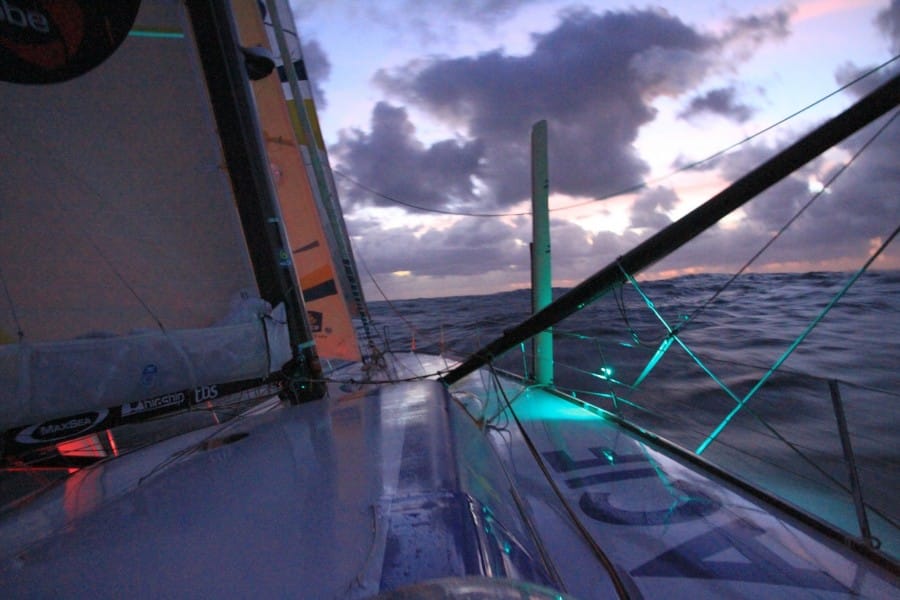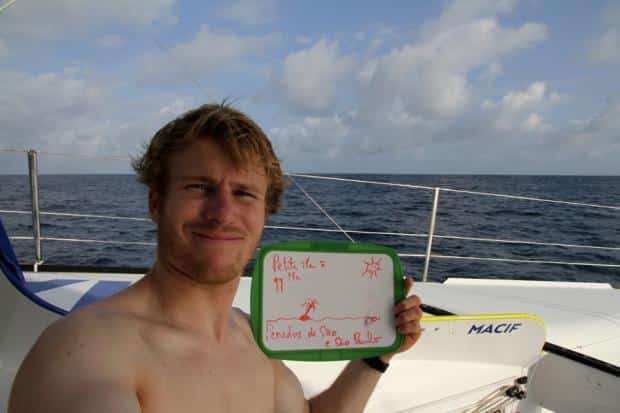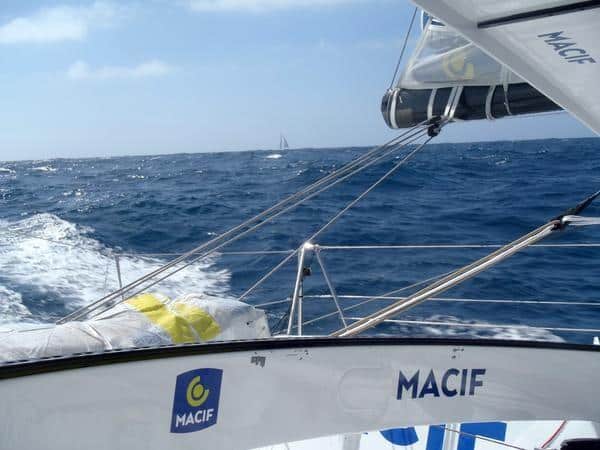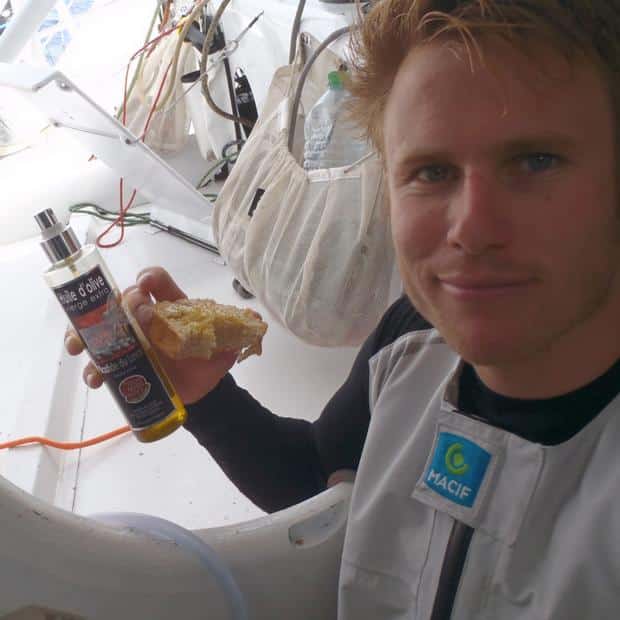
Gabart Vendee Globe
It is hard to know just how much Francois Gabart (Macif) thinks about the possibility that he could be the youngest sailor in history to win the fabled Vendée Globe race in just a few days at the age of 29. When I spoke with him by phone as he approached the doldrums in the Atlantic, he seem more concerned about maintaining his lead of a hundred miles or so ahead of the more experienced and very, very capable Armel Le Cléac’h (Banque Populaire) than the not-so-lofty chance that he could be the victor. After all, Gabart and Le Cléac’h were battling each other to stay ahead as they approached the Cape Horn, trading first and second place over 130 times while remaining in sight of each other. Gabart also knows, of course, that almost anything can happen between now and before making it back to the Sables-d’Olonne, which is now about 2,500 miles away.
Instead of daring to think about the specter of winning and how he might deal with the sudden rock star-like fame waiting for him back on shore after living alone on a metal drum for almost three months, Gabart is thinking about sailing. Keeping his lead, of course, involves constantly monitoring of the weather, sails, and instruments and dealing with both minor and often major breakages than it does with predicting what can happen in a few days.

Gabart enjoys some warm weather not far from the equator. Photo: F.Gabart/Macif
But this is also the Vendée Globe. Just finishing the longest, most brutal, and ultimately, the most fabled offshore solo race in the world inevitably carries with it extreme emotional highs and lows. Jean-Pierre Dick (Virbac Paprec), who is in third place, said he has spent some time crying a few days ago, and he is certainly not the only sailor in the fleet to do that. Gabart admitted that he has wept a bit as well, although he said he cried more often out of joy. This is just the way things are when you are alone on the ocean and sailing against ferocious competitors in the Vendée Globe, they say.
**SW: What do you expect your main challenges will be as you make your way through the doldrums? **
FG: I became used to having other boats around me, but now, Armel is 100 miles away. When you can see the other boats, you know right away if your speed is okay or not. One of my main goals now is to make sure that the boat is going as fast as it can. Even if the trade winds are not stable, blowing only at 10 knots, you have to make sure you choose the right sail and keep a good speed.
The timing of my next tack is important, too. If you go too much to the east, you remain there farther for six days longer than you want to. If you tack too early, you will be too much in the west.
SW: What variables will you take into consideration when you make your decision about the time of your next tack?
FG: I will first have prepared the flat sail for going upwind, so I will probably use my flat sail for a few days because afterwards I will be reaching in 15-20 knots.
The weather conditions are the most important thing. The software will calculate the route as it takes [the weather into consideration]. But in addition to that, I rely on my own feeling that I have as well, when deciding when the best time to tack is.
SW: While it is definitely easier to sail faster with the competing boats in sight, it must be a relief when you can distance yourself from Armel [Le Cléac’h].
FG: I don’t miss him at all [laughs].
The finish is still far, far away, but it is getting closer. All the miles I have in front of him is a good thing to have. But of course, I will be happy if I can keep 200 miles ahead of him.
Being about 80 miles ahead of him in the doldrums is a good position to be in.
SW: When and how did you take the lead after it was so close before Cape Horn?
FG: I think I was a little bit faster than Armel at the end of the Pacific when sailing with a gennaker in 25-30 knots of wind. I was sailing 1 to 2 knots faster than him for a couple of days, so I was 30 miles in front of him at the Cape Horn, which helped me to stay in the lead. After that, our strategies were a bit different after the Falkland Islands when Armel stayed a little bit more in the east and I took a more westerly route where I had stronger winds for longer than he did.
SW: When you were within eyesight of Armel and you continued to battle it out with him for first place, were you reminded of Le Figaro race?
FG: Yeah [laughing], a little bit, except in that race you have about 20 or 30 boats close to you and in this race, I could only see Armel’s boat. But the constant pressure and the fight I had with Armel could be compared to what you experience in Le Figaro.

Gabart and Le Cléac’h battled it out for the lead until Gabart put some distance ahead between them after the Cape Horn. Photo: F.Gabart/Macif
SW: Can you describe how you are feeling? Are you able to have fun sailing?
FG: I am in good shape, and I am a little bit tired after sailing for two months. I am not as fresh as I was at the start of the race. If you are running a marathon, after 20 or 30 kilometers you are, of course, more tired than you were at the start, but this does not mean that you are running too fast, but are running at the right speed. I am in good shape and am trying to do all I can to race. And I am ready to fight for the final part of this race and am in good shape for it.
SW: Jean-Pierre Dick said the other day that he has experienced some emotional highs and lows during the race and has admitted that he has spent some time crying. Have you experienced emotions like that as well?
FG: Yes, of course. This race causes so many strong emotions … the feelings you have are stronger than they are when you are onshore; when you are happy, you are very, very happy and when you are sad, you are very, very sad. I was actually crying for joy at one point and was very, very happy. Sometimes, you wish you were onshore with your loved ones and you cry a little bit, but it is not bad, it is good.

Enjoying some olive oil a few weeks after the start. Photo: Gabart/Macif
SW: What has been the most difficult moment of the race?
FG: Conditions near New Zealand were difficult. The winds were strong and shifty. The winds varied between 20 and 50 knots. I would have preferred a wind of 50 knots if it were steady. The wind at one point reached 55 knots near Auckland Island. It is difficult to measure the size of the waves, but they were definitely powerful, which made sailing difficult.
I had two reefs in the mainsail then. The problem is that when the wind is unstable, you are very slow when you have three reefs at 20 knots and when the next boat is five miles in front, you have to have fewer reefs. So you really need to find a balance with a sail for low and high winds.
When the winds reached 50 to 55 knots near Auckland Island, I only had one reef in the main [laughing] and used either a fractional gennaker or reacher. But the wind only remained at 50 knots for five minutes. So, for five minutes I [focused] on steering and trying not to break anything.
I used the fractional gennaker until the wind reached 35 to 38 knots and then the reacher for stronger winds. I was running downwind. With one reef, you don’t have much choice about where you want to go [laughing].
SW: So obviously, you were taking a risk?
FG: Yes, for sure. I mean the wind was just 25 knots a few minutes before and the wind was only at 50 knots for about five minutes. I could have had many breakages, and so yes, it was a risk. But like I said before, when you are sailing with three reefs, you cannot lead the Vendée Globe. You have to keep a good balance. Sometimes you have to keep some size in the sails for big wave conditions, because if you are going too slowly, slower than the waves, the boat can be at risk. Sometimes, you need to keep some size in the mainsail and the gennaker and make sure that you maintain 20 to 22 knots to navigate in big wave conditions.
SW: Your’s and Armel’s boats are among the fastest and newest in the fleet. How much have the newer technologies and design helped you to stay ahead in the race?
FG: This is difficult to answer. Sure, we both have very good boats. But I don’t know exactly the performance advantages they offer. The Vendée Globe race officially started November 10, but for me, it started when I first began to build this boat, and it is certainly fast.
But it is hard to separate the boat from the skipper. In a way, I am part of the boat, and the boat is part of me right now. After sailing the boat for more than two months, we are now one. If I put my boat in the hands of someone else, he wouldn’t use it in the same way that I do so.









